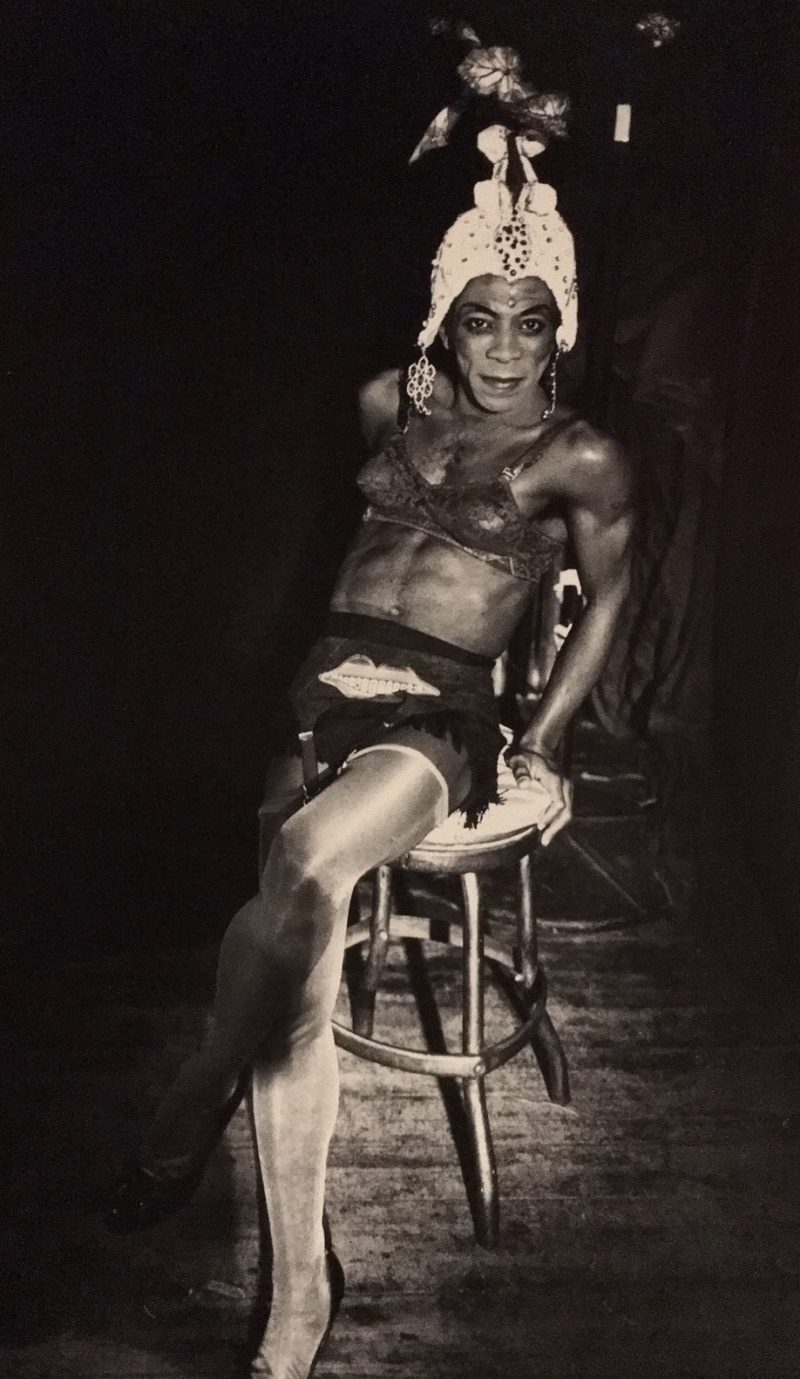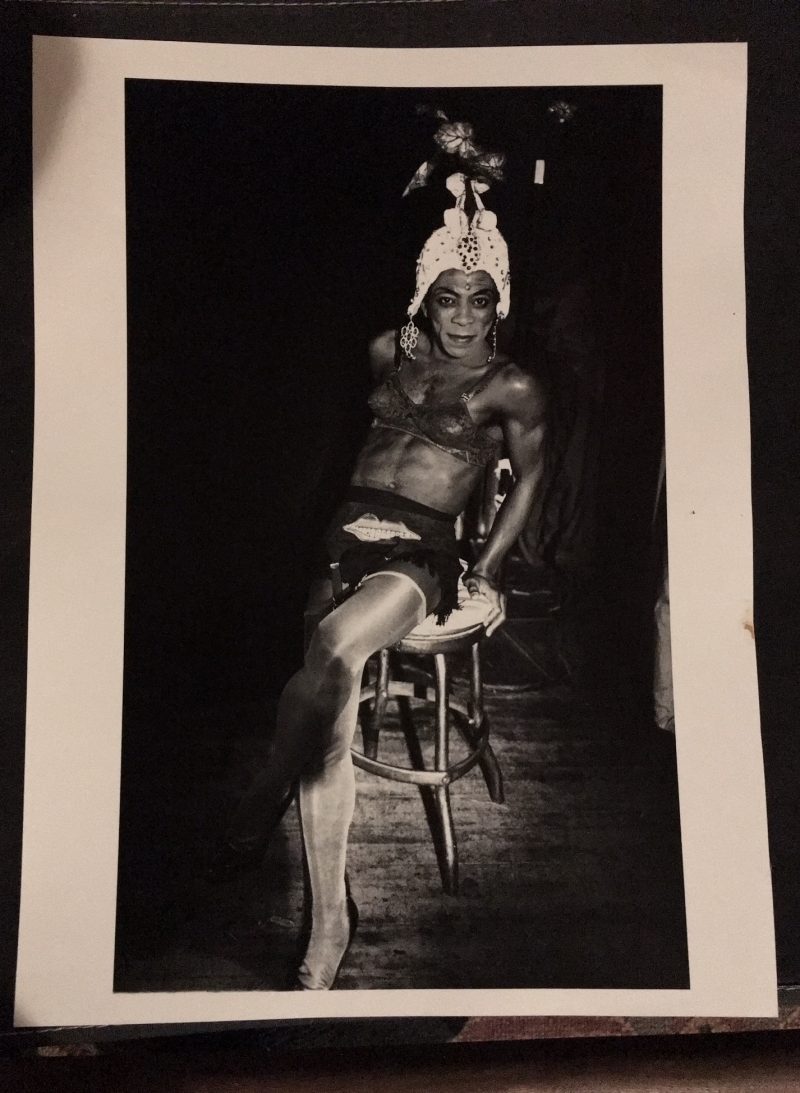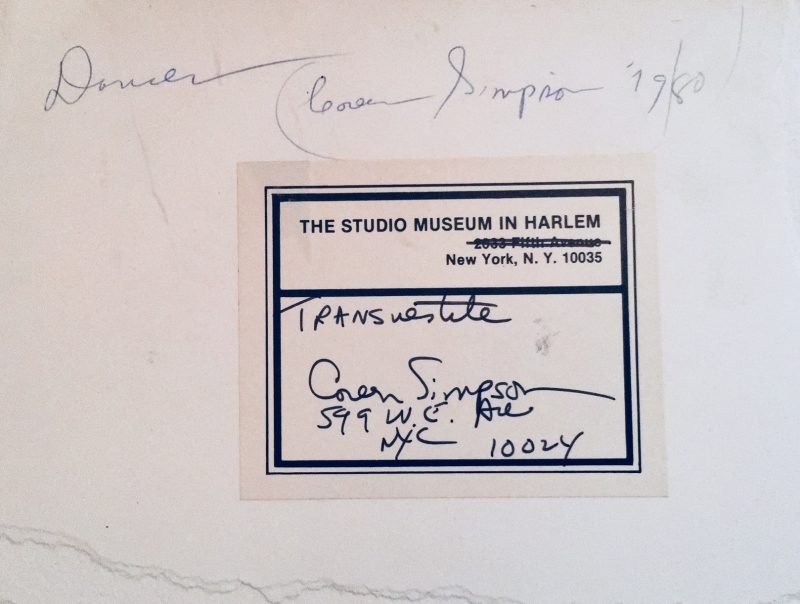SOLD. Original Photo by Coreen Simpson 1980
Original Silver Gelatin (printed in darkroom) Photograph, Taken by Coreen Simpson (born February 18, 1942). Print comes with signed and tilted label on matt board with the following handwritten info ” The Studio Museum in Harlem, New York, NY. 10035. “Tranvestite 1980″. Coreen Simpson, 599 W.C. Ave. NYC. 10024.” Paper meausres 10.25 x 14 inches. Image measures 8 x 13 inches. Very mild aging and one chemical stain on the white border (not the main image).
SOLD.
““““““““““““““`
Coreen Simpson’s portraits and performative documentary photography include a wide variety of subjects. Her work reveals a depth of character and dignity for her subjects which have garnered comparisons to the complex photographs of Diane Arbus and Wegee. Today, her work is represented in private collections and numerous institutions including The Museum of Modern Art, The Brooklyn Museum, International Center of Photography, The Bronx Museum of the Arts, La Musee De La Photographie in Belgium, The Peter Norton Family Collection, The Rush Foundation, The Library of Congress, the Smithsonian Institution and the Schomburg Center for Research in Black Culture. Her “power images” were featured in the Tony Award winning Broadway musical, “Bring in DA Noise, Bring in Da Funk.” In addition, Ms. Simpson has received grants for her works from the New York State Council for the Arts,
Light Work, and The New York Foundation for the Arts.
“““““““““““““
MORE INFO:
https://www.theobservers.co/blog-people/coreen-simpson
http://www.theblackcameocollection.com/coreen_simpson.html
|
Coreen Simpson
|
|
|---|---|
| Born | February 18, 1942
|
| Nationality | American |
| Occupation | Photographer Jewelry designer |
| Years active | early 1980s-present |
Coreen Simpson (born February 18, 1942) is a noted African-American photographer and jewelry designer, whose work has an African-American theme.
Simpson was born in New York City. She took courses at the Fashion Institute of Technology and Parsons School of Design, and studied with Frank Stewart, Studio Museum in Harlem in 1977.[1]
Simpson’s career launched when she became editor for Unique New York magazine in 1980, and she began photographing to illustrate her articles.[1] She then became a freelance fashion photographer for the Village Voice and the Amsterdam News in the early 1980s, and covered many African-American cultural and political events in the mid-1980s. She is also noted for her studies of Harlem nightlife. She constructed a portable studio and brought it to clubs in downtown Manhattan, barbershops in Harlem, and braiding salons in Queens.[1]Her work’s ability to present a wide variety of subjects with “depth of character and dignity” has been compared to that of Diane Arbus and Weegee.[2]
In addition to her photography, Simpson also designed jewelry.[3] Her most notable jewelry collection is known as The Black Cameo (1990). The collection reintroduces the ancient tradition of cameos, but features portraits of black women. The portraits show the great variety of features of black women. Simpson’s goal was that every black women would be able to identify with the portraits within her cameo jewelry.[4] Customers of the Black Cameo collection included Ruby Dee and Oprah Winfrey.[5]
Simpson and Avon Products entered a joint venture in 1993 and created the Coreen Simpson Regal Beauty Collection, a budget line of designs which included a moderately-priced African American cameo.[6]
Simpson resides in New York City.
Simpson’s works have been collected by the Museum of Modern Art, the Bronx Museum of the Arts, the Musee de la Photographie in Belgium, the Schomburg Center for Research in Black Culture,[7] the International Center for Photography, the Harlem State Office, and the James Van Der Zee Institute.[8]
- 1998: Bronx Museum of the Arts, Bronx, NY
- 1998: International Center of Photography, New York, NY
- 1998: Musée de la Photographie, Brussels, Belgium
- 1999: Schomburg Center for Research in Black Culture, New York, NY
- 2000: Anacostia Museum/Smithsonian, Washington, DC
- 2001: Bronx Museum of the Arts, Bronx, NY
- 2001: Brooklyn Museum, Brooklyn, NY
- 1987: Light Work Residency
- Nueva Luz, Volume 1#2
- 1994: The Mary McLeod Bethune Award from the National Council of Negro Women
- 2000: The Madame C.J. Walker Award
- 2006: The National Council of Negro Women “Legend’s Award”
- Jeanne Moutoussamy-Ashe, Black Women Photographers, Writers & Readers, 1993
- Coreen Simpson, Black Women in America, MacMillan, 1999
|
Crucially Performative: The Photographic Art of Coreen Simpson. by Horace Brockington Crucially Performative: The Photographic Art of Coreen Simpson. Coreen Simpson emerged within the context of photographers when the medium was still locked within traditional constrictions. It was a strictly male-dominated field–especially among Black photographers where certain groups such as the Kamonge Workshop adhered to some rather restrictive stylistic nuances and thematic boundaries for creating photographic art. Simpson, along with Black female contemporaries, Ming Smith, Gail Hansberry, and Fern Logan, managed to move skillfully around the limited context of a traditional art medium, and the context imposed by their male counterparts in order to create unique bodies of works. Originally a writer, Coreen Simpson moved to photography in order to illustrate her articles. She has worked as a freelance photographer for New York’s Village Voice, and an international fashion photographer for various magazines. Simpson moved farther left than most of the artists within this 70s,and early 80s, in order to reconstruct the performative and conceptual context of the photographic art. Her work moves her closer to artists such as Mapplethorpe, and foreshadowed artists such as William Coupon, Peter Hugar, and Nan Goldin. A younger generation of Black artists working in the photographic medium has dominated the exhibition enterprises by curators and institutions over the last two decades, including, Carrie Mae Weems, Lorna Simpson, Cynthia Wiggins, etc, exploring what can be characterized as the more conceptual possibilities of using the photographic medium to explore thematic and intra-textual possibilities of art and image. Others such as Bill Gaskin, Dawoud Bey, Stephen Marc, Renee Cox, Lyle Ashton Harris, have aligned themselves to some of the more traditional aspects of the photographic medium in order to give their work both narrative potential and engage important aspects of art and individual in a contemporary reality. However, the work of Simpson, while never directly embracing any of these strategies, offered the direction for many of these younger artists whose works come after her. The allusive importance of Simpson’s work can be attributed to two situations. First, she has always refused to be boxed, thus making it difficult for galleries or curators who are more comfortable with artists they can compartmentalize in rather restricted definitions. Second, a major fire in her studio destroyed negatives and prints of many of her early works. However as both a curator, and art historian, I had the opportunity to exhibit the work back in the 80s and therefore familiar with a host of works by the artist and can therefore attest to its importance within the larger context of art /photographic history. Coreen Simpson is less interested in the process of photographic art or sequence, even though she came into photography at period when photographers such as Benno Friedman and a host of others wanted to expand photography into the artistic frame by exploring ways of incorporating physical alteration to the process, and surface including, such processes as drawing onto the work, which in the present days of digital processed photography appears almost archaic. However the concern with many of these artists was to push photography out of its staid limitations and by extension challenge the disciplines of sculpture and painting. Other artists, such as Samaras, coming from more traditional artistic mediums, embraced photography, and succeeded in expanding the medium as powerful format in contemporary and recent art. During this period, Simpson explored these tendencies by adding acrylic, oil paint, finger nail polish, colored markers to mural sized photographs. However, for Simpson, manipulation methodology soon ceased to be of interest; she moved away from that approach for a more documentary style of photography Simpson never rejected the conceptual and minimal strategies of the photographic art, but rather embraced two key aspects of photographic potential that have since characterized works by artists such as Nan Goldin on one end of the spectrum, and Sandy Skogland on the other–namely the performative aspects of the work. In this context, her work focused on the internal context of the “sitter”/place to give the work a performative, theatrical quality. However, again Simpson’s works remain distinct in that she was equally interested in the point at which the performative aspects and the context of place within the frame of the work spoke to the visible “place” and self. In this context her early works predate much of the identity politics-driven work which was to be a main theme for late 80s and 90s art. This is acute in some of her early works, especially her hair series–which predates many other artists’ exploration of the implication of Black hair–and her B-Boys Series–which looks squarely at hip, hop culture before many mainstream photographers more recently artists such as Nikki Lee. Simpson’s B-Boy Series as well as her series of photographs of New York City nightlife reflected Simpson’s interest in way individuals decorate themselves and use adornment as a tool for self-identification. In her photographic works, Simpson pushed the potential of meaning and imagery to provide a raw, direct view of a changing urban reality while exploring issues of sexuality, gender and race identification. Many of her early works of alternative culture(s) and nightlife comment on the legible difference between the ontologically “male ” or “female.” Her more surreal images echoed Joel-Peter Witkin’s physical and psychological dysfunction but projected a directness that is less about the imagined reality of a Fellini-esque world, but one that speaks to the viewer about a type of escapism from a culture and a technologically imposing world. In Simpson’s art, masquerading is natural or rather a different type of authenticity. Her “portraits” by their mere presence establish a vocabulary of authenticity. However, Simpson works are less about racial authenticity or aims to characterize that which is “racially real,” than they are about the individual and those markers that at the moment offer the greatest possibilities of interpreting the visual, cultural, and self as perceived as internal and psychological. Consequentially, in Simpson’s work, the theme may be the ethnic, but the variation is individual. In this context, her works/imagery produce a version of authenticy that is new, powerful, and propose the possibilities of gender and the affirmation of any notion of “self” as conscious and open ended. Earlier I referred to Coreen Simpson’s images as highly performative, but they are never about the dialectics of language, rather discourses about intimacy, expectation, and denial. The works are never pessimistic, and perhaps this is where her works depart from her contemporaries such as Goldin, or early “club ” works by William Coupon and others. A precise handling of setting, structure and characterization in her works provide a tone and point of view that raises her themes to explore the relationship between the individual and the environment. Despite the intimacy of many of her work, Simpson’s image are never voyeuristic, rather her explorations of the private and the personal pushes the dynamics between viewer and image, breaking down the outside/inside barriers, inviting us to come into the world of the sitter or environment of the work. As such, she provides a type of third person narrative in order to guide the viewer to understand or least explore the complexity of sitter or place. With the introduction of text driven photographic works at the end of the 20th century, Simpson could have easily jumped on the bandwagon with works that would have made her an international art “star.” Instead, she rejects the notion of text and continues to rely on the image to provide its own narrative or conceptual potential. Despite the lack of text, her photographic images remain loaded complex works rich in vision and language linked to performance, theatrics, constantly pushing at the boundaries of representations, and materiality. Simpson finds her own way to explore any notion of a vernacular, cultural logic of racial identification as visible, public, or natural. She rejects any reliance on external devices to convey meaning or intent in her work. Coreen Simpson’s artworks reject simple boundaries in order to embrace the body; they question the authenticity and complexities of cultures, identities and genders, the significance of difference without having to forfeit their true definitions as photographs. Her works have a narrative interiority that had no place in conceptual practices. Her work is ultimately informed by the need to open up enormous implications associated with photography and art in a post-modernists context, but equally to articulate a commitment to life as crucially performative. Simpson has always repudiated that her art could be easily defined. She understood from the start that art requires invention, artifice, imaginations, and not art as intellect or reportage. She rejects the cerebral because she wants the art to be “there.” Simpson has often rejected the relevance of the art historical to expand her own works, as such her works have often been denied the historical analysis they truly deserve, while remaining an important link in contemporary art history. Not only for historical analogies but predictions. http://www.nyartsmagazine.com/index.php?option=com_content&task=view&id=2307&Itemid=698
|


